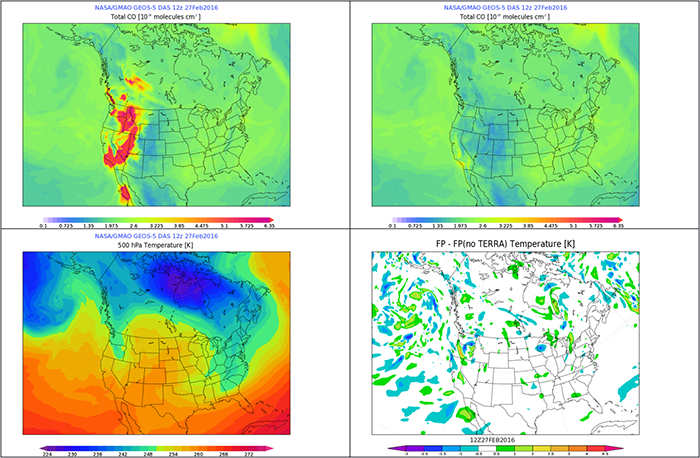GEOS System News
GEOS-5 products re-computed to eliminate erroneous biomass-burning fields
March 3, 2016
As previously reported, biomass-burning emissions in GEOS-5 between February 25 and early March were contaminated by erroneous satellite data that were not excluded by GMAO's quality-control procedures. Because of the severity of these signals in carbon monoxide and other fields, GEOS-5 analyses have been re-run for the period February 25, 2016, through March 2, 2016. All inputs from the EOS-Terra MODIS instrument have been turned off. As of 00Z on March 3, 2016, all meteorological analyses and forecasts produced using GEOS-5 are using these uncontaminated constituent emission distributions.
The figures below show GEOS-5 (forward-processing stream) fields at 12Z on February 27, 2016. The total-column carbon monoxide values from the two GEOS-5 analyses without (top left) and with (top right) EOS-Terra/MODIS observations reveal marked differences along the Western quarter of North America. While these CO fields do not impact the circulation, aerosols emitted by biomass burning do have an impact because of their physical forcing in the atmosphere. There is a small impact on the meteorological fields in GEOS-5. For example, temperature plots at 500-hPa are dominated by the coherent structures associated with climate and weather patterns (bottom left) and show small, near-random differences, generally of less than a few tenths of one degree but sometimes exceeding 1.5 degrees, part of which can be attributed to the availability of other observations that were not included in the original analyses.
To introduce these changes, GMAO will take the following steps:
- 25-km-resolution global analyses, produced by the GEOS-5 forward-processing (FP) system, that are distributed via the NCCS data portal mechanisms (FTP & OpenDAP) will be replaced for the period February 25-March 2, 2016.
- Forecasts initialized using these analyses will not be re-run, meaning that there will be an inconsistency between the forecasts and the analyses.
- Beginning at 00Z on March 3, 2016, all GEOS-5 FP analyses and forecasts will be produced using the corrected data streams.
- 50-km-resolution GEOS-5 FP-IT analysis datasets, distributed to subscribing NASA Instrument Teams via the GES-DISC, will remain archived and a second (corrected) version of these datasets has been added to the archive using version numbering. Beginning at 12Z on March 2, 2016 the corrected system generated standard products as usual.
- Reanalysis (MERRA-2) datasets will not be impacted.
We apologize for any inconvenience caused by this.


